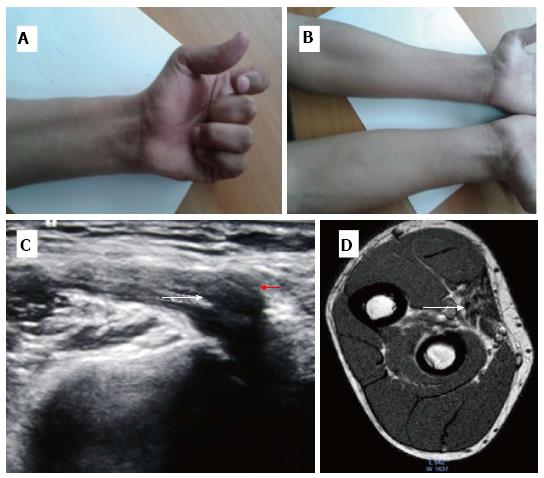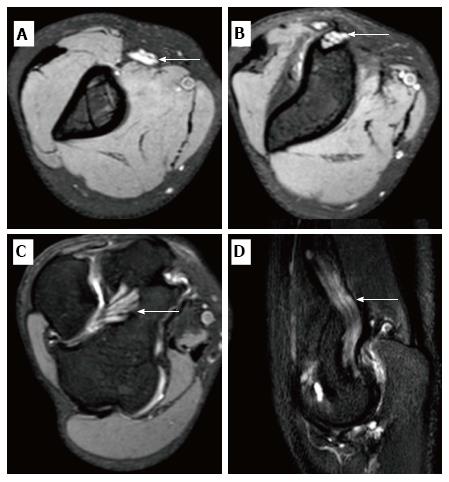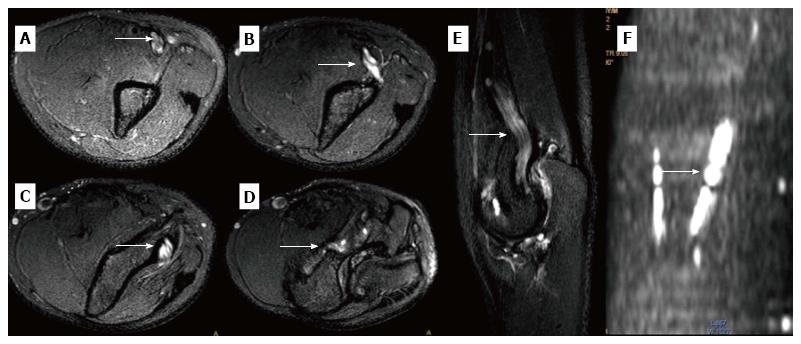Published online Oct 28, 2017. doi: 10.4329/wjr.v9.i10.400
Peer-review started: February 14, 2017
First decision: April 19, 2017
Revised: June 24, 2017
Accepted: July 7, 2017
Article in press: July 10, 2017
Published online: October 28, 2017
Processing time: 254 Days and 4.1 Hours
Intraosseous entrapment of the median nerve is an uncommon complication of elbow dislocation and fractures. The condition is seen to occur in adolescent age group with a remote history of trauma. We report two rare cases of type 2 intraosseous median nerve entrapment. Though the diagnosis of median neuropathy is made with clinical tests and neurophysiological studies, however exact site of entrapment and presurgical mapping of nerve is done accurately with MR neurography. Imaging thus plays a pivotal role in management of this condition.
Core tip: Intraosseous entrapment of median nerve at the level of elbow joint is rare but serious complication of closed reduction of posterior elbow dislocation. We report two cases of type 2 intraosseous medan nerve entrapment (wherein the median nerve gets entrapped in fractured medial epicondyle) and discuss the role of MR neurography. MR delineates the posterior course of median nerve with altered signal intensity, thickening and loss of fascicular pattern. In addition, secondary denervation changes in muscles supplied by median nerve is indirect evidence of nerve pathology. Management of such cases would differ depending on the time of diagnosis.
- Citation: Aggarwal A, Jana M, Kumar V, Srivastava DN, Garg K. MR neurography in intraosseous median nerve entrapment. World J Radiol 2017; 9(10): 400-404
- URL: https://www.wjgnet.com/1949-8470/full/v9/i10/400.htm
- DOI: https://dx.doi.org/10.4329/wjr.v9.i10.400
Intraosseous entrapment of the median nerve at the level of elbow joint is a rare but serious complication of closed reduction of posterior elbow dislocation[1]. The diagnosis often gets delayed due to subtle symptoms which leads to grave damage to nerve. Imaging plays a major role preoperatively determining the site of entrapment. We report two cases of type 2 intraosseous median nerve entrapment and discuss their MR neurography findings.
An 18-year-old male suffered fracture of medial epicondyle of left humerus along with elbow dislocation after he fell from rooftop about two years back. He was managed with closed reduction of elbow, followed by cast immobilization and physiotherapy. After removal of cast, he progressively started having symptoms of median neuropathy in the form of numbness and paresthesia along the median nerve distribution in forearm and hand with inability to form a fist and weak hand movements (Figure 1A). Gradually there was thinning of the forearm muscles. On clinical examination, there was atrophy of forearm muscles (of the anterior compartment) and of thenar muscles (Figure 1B). He had weakness of small hand muscles as well in the median nerve distribution. Clinical impression was median nerve palsy. Ulnar and radial nerve function was normal on clinical examination. Nerve conduction studies revealed median nerve neuropathy at the level of elbow.
High resolution USG was done, which revealed grossly thickened and hypoechoic median nerve in the region of distal arm with an abrupt cut off at the level of elbow (Figure 1C). The nerve fibers were seen coursing posteriorly and distal median nerve could not be traced. Limited MR neurography of the elbow was done for further confirmation of diagnosis.It revealed the median nerve to be swollen and having abnormal signal intensity (hyperintense on T2) in the distal arm (Figures 1D and 2). It was seen to have an altered course as the median nerve was seen to course posteriorly through the fractured medial epicondyle and subsequently was entrapped between the olecranon of ulna and olecranon fossa of humerus. Thereafter, the nerve was not visualized for some distance after which it reappeared with decreased calibre in its normal course in forearm with normal signal intensity. The muscles of the anterior compartment, supplied by median nerve, showed hyperintense signal on T1w and T2w sequence suggesting chronic denervation with fatty infiltration. These features were suggestive of type 2 median nerve entrapment.
A 20-year-old patient suffered supracondylar fracture of humerus 1 year back. The patient was managed conservatively by immobilization. Patient noticed weakness of hand grip and hand movements and decreased sensations of lateral half of forearm and lateral half of hand after immobilization was removed.
On examination, there was atrophy of anterior compartment muscles of right forearm and thenar eminence of hand. There was weakness of lateral half of hand fingers. All tests for median nerve were also positive in this case. NCV confirmed median neuropathy with likely site to be at elbow.
MR neurography revealed markedly thickened median nerve and was T2 hyperintense in the region of arm proximal to fracture site and traversed through the fractured fragment of humerus and coursed posteriorly (Figure 3). The nerve was entrapped between the olecranon and olecranon fossa and was seen coursing anteriorly back to its normal course with normal intensity and mildly decreased thickness. There was secondary atrophy of flexor digitorum profundus (lateral belly), flexor digitorum superficialis, flexor pollicis longus, pronator teres and of thenar muscles with fatty change s/o chronic insult.
Intraosseous median nerve entrapment is relatively rare complication of elbow dislocation and fractures of lower end humeral, frequency of which varies from 1%-12.5%[2]. It was first described by Gurdjian and Smathers[3] in 1945. The condition is seen to occur in a relative younger age group (adolescents)with a slight male predominance[4].
Four types of intraosseous median nerve entrapment are described[5]. The first three types have been described by Hallet while type IV was described by al-Danielsson et al[6], Hallett et al[7], Steiger et al[8], Ozkoç et al[9], Noonan et al[10]. In type 1 intraosseous median nerve entrapment, the medial collateral ligament is torn and the median nerve slips posteriorly adhering to the posterior surface of humerus and gets entrapped between trochlea and olecranon process. In type 2, median nerve is entrapped in the fractured medial epicondyle. Type 3 is when nerve gets entrapped between the distal end of humerus and ulna in the ulno-humeral joint without any fracture. Type 4 is combination of type 1 and 2[11]. Both our cases were of type 2 variety; the median nerve was entrapped in the fractured medial epicondyle. Both the patients were young adolescent males having a remote history of trauma and were managednon-operatively.
Intraosseous entrapment of the median nerve should be suspected when there is failure of concentric reduction, presence of joint widening post reduction or the clinical symptoms persist or if there occurs cortical depression with surrounding sclerotic changes in the distal metaphysis of humerus(matev sign)[1,12,13].
Imaging played a pivotal role in preoperative diagnosis of this condition. Altered signal intensity and thickening of the median nerve with loss of fascicular pattern pointed towards the abnormality of the nerve. MRI clearly delineated the posterior course of the median nerve. In addition, secondary denervation changes in muscles supplied by median nerve were also seen.
Management of such cases would differ depending on the time of diagnosis. Usually the symptoms of median nerve entrapment are mild hence detection of this neuropathy is delayed. If detected early, relocation of the nerve from posterior to anterior compartment is done. If detected later then excision of the diseased segment with either nerve repair (end to end) or nerve grafting is done (with sural nerve graft). Early diagnosis and treatment ensures better prognosis. Both the cases we encountered were of chronic insult due to delayed diagnosis. The first case was lost to follow up and the second underwent nerve grafting.
MR neurography plays a vital role in the diagnosis of intraosseous entrapment of median nerve following medial epicondyle fracture by clearly demonstrating its altered course in the posterior compartment leading to its entrapment. In addition, presurgical mapping of the nerve can be accurately done with MRI and it also helps in deciding the correct management of the patient.
Numbness and paresthesia along the median nerve distribution in forearm and hand with inability to form a fist, and weak hand movements with gradual thinning of the forearm muscles.
Weakness and atrophy of muscles of median nerve distribution.
Traumatic/entrapment/infectious/inflammatory neuropathy.
Nerve conduction study will reveal reduced velocity across the median nerve.
MR delineates the posterior course of median nerve with altered signal intensity, thickening and loss of fascicular pattern.
Neuropathy at the fracture level.
If detected early, relocation of the nerve from posterior to anterior compartment is done and if detected later then excision of the diseased segment with either nerve repair (end to end) or nerve grafting is done (with sural nerve graft).
Four types of intraosseous median nerve entrapment are described. Intraosseous entrapment of the median nerve should be suspected when there is failure of concentric reduction, presence of joint widening post reduction or the clinical symptoms persist or if there occurs cortical depression with surrounding sclerotic changes in the distal metaphysis of humerus (matev sign). MRI clearly delineated the posterior course of the median nerve. In addition, secondary denervation changes in muscles supplied by median nerve were also seen.
Intraosseous entrapment of the median nerve is a rare complication of closed reduction of posterior elbow dislocation.
MR neurography plays a vital role in the diagnosis of intraosseous entrapment of median nerve following medial epicondyle fracture by clearly demonstrating its altered course in the posterior compartment leading to its entrapment.
The case studies are described clearly and it is easy for the reader to follow.
Manuscript source: Unsolicited manuscript
Specialty type: Radiology, nuclear medicine and medical imaging
Country of origin: India
Peer-review report classification
Grade A (Excellent): 0
Grade B (Very good): B
Grade C (Good): 0
Grade D (Fair): 0
Grade E (Poor): 0
P- Reviewer: Demonacos C S- Editor: Ji FF L- Editor: A E- Editor: Lu YJ
| 1. | Gurdjian ES, Smathers HM. Peripheral nerve injury in fractures and dislocations of long bones. J Neurosurg. 1945;2:202-219. [RCA] [DOI] [Full Text] [Cited by in Crossref: 18] [Cited by in RCA: 13] [Article Influence: 0.2] [Reference Citation Analysis (0)] |
| 2. | Landin LA, Danielsson LG. Elbow fractures in children. An epidemiological analysis of 589 cases. Acta Orthop Scand. 1986;57:309-312. [RCA] [PubMed] [DOI] [Full Text] [Cited by in Crossref: 183] [Cited by in RCA: 142] [Article Influence: 3.6] [Reference Citation Analysis (0)] |
| 3. | Fourrier P, Levai JP, Collin JP. [Median nerve entrapment in elbow dislocation]. Rev Chir Orthop Reparatrice Appar Mot. 1977;63:13-16. [PubMed] |
| 4. | al-Qattan MM, Zuker RM, Weinberg MJ. Type 4 median nerve entrapment after elbow dislocation. J Hand Surg Br. 1994;19:613-615. [RCA] [PubMed] [DOI] [Full Text] [Cited by in Crossref: 14] [Cited by in RCA: 18] [Article Influence: 0.6] [Reference Citation Analysis (0)] |
| 5. | Ayala H, De Pablos J, Gonzalez J, Martinez A. Entrapment of the median nerve after posterior dislocation of the elbow. Microsurgery. 1983;4:215-220. [RCA] [DOI] [Full Text] [Cited by in Crossref: 10] [Cited by in RCA: 10] [Article Influence: 0.2] [Reference Citation Analysis (0)] |
| 6. | Danielsson LG. Median nerve entrapment in elbow dislocation. A case report. Acta Orthop Scand. 1986;57:450-452. [RCA] [PubMed] [DOI] [Full Text] [Cited by in Crossref: 16] [Cited by in RCA: 16] [Article Influence: 0.4] [Reference Citation Analysis (0)] |
| 7. | Hallett J. Entrapment of the median nerve after dislocation of the elbow. A case report. J Bone Joint Surg Br. 1981;63-B:408-412. [PubMed] |
| 8. | Steiger RN, Larrick RB, Meyer TL. Median-nerve entrapment following elbow dislocation in children. A report of two cases. J Bone Joint Surg Am. 1969;51:381-385. [RCA] [PubMed] [DOI] [Full Text] [Cited by in Crossref: 19] [Cited by in RCA: 18] [Article Influence: 0.3] [Reference Citation Analysis (0)] |
| 9. | Ozkoç G, Akpinar S, Hersekli MA, Ozalay M, Uysal M, Tandoğan NR. Type 4 median nerve entrapment in a child after elbow dislocation. Arch Orthop Trauma Surg. 2003;123:555-557. [RCA] [PubMed] [DOI] [Full Text] [Cited by in Crossref: 10] [Cited by in RCA: 10] [Article Influence: 0.5] [Reference Citation Analysis (0)] |
| 10. | Noonan KJ, Blair WF. Chronic median-nerve entrapment after posterior fracture-dislocation of the elbow. A case report. J Bone Joint Surg Am. 1995;77:1572-1575. [RCA] [PubMed] [DOI] [Full Text] [Cited by in Crossref: 25] [Cited by in RCA: 19] [Article Influence: 0.6] [Reference Citation Analysis (0)] |
| 11. | Webb S, Lourie J. Median nerve entrapment in an unreduced fracture-dislocation of the elbow: case report. P N G Med J. 1986;29:185-187. [PubMed] |
| 12. | Matev I. A radiological sign of entrapment of the median nerve in the elbow joint after posterior dislocation. A report of two cases. J Bone Joint Surg Br. 1976;58:353-355. [PubMed] |
| 13. | Simon D, Masquijo JJ, Duncan MJ, Kontio K. Intra-articular median nerve incarceration after spontaneous reduction of a pediatric elbow dislocation: case report and review of the literature. J Pediatr Orthop. 2010;30:125-129. [RCA] [PubMed] [DOI] [Full Text] [Cited by in Crossref: 9] [Cited by in RCA: 11] [Article Influence: 0.7] [Reference Citation Analysis (0)] |















